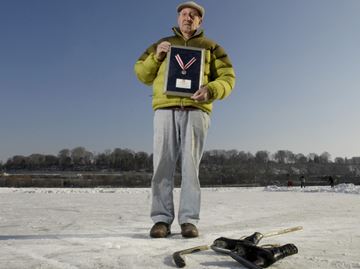 If you do not read THE HAMILTON SPECTATOR then you missed a really nice article and obituary for SAM SHAPIRO. Mr. Shapiro passed away Monday January 20, 2014. I was impressed by this man who was in World War 2 and who it seemed helped out in the real life GREAT ESCAPE in Germany. This man is someone who you should read about. So continue on and read more.
If you do not read THE HAMILTON SPECTATOR then you missed a really nice article and obituary for SAM SHAPIRO. Mr. Shapiro passed away Monday January 20, 2014. I was impressed by this man who was in World War 2 and who it seemed helped out in the real life GREAT ESCAPE in Germany. This man is someone who you should read about. So continue on and read more.
Shapiro who helped dig tunnels for ‘Great Escape’
By Daniel Nolan
Sam Shapiro was a Royal Canadian Air Force pilot who was shot down and captured during the Second World War and a Jew who survived four years in Hitler’s Germany.
The Ancaster resident spent time in Stalag Luft III prison camp, which was the scene of a daring breakout by 76 Allied airmen. It was later depicted in the 1963 Hollywood blockbuster The Great Escape.
Shapiro did not take part in the breakout in March 1944 from the Luftwaffe-run prisoner of war camp in East Germany (now part of Poland), but he did work on the tunnels. Three of the men managed to elude recapture and of those apprehended, 50 were executed by Nazi officials.
“We all dug,” Shapiro told The Spectator in 1999. “The main tunnel and two diversionary tunnels. Seventy-six men got out and they murdered 50 of them, but we tied up almost 30,000 of their soldiers looking for them.”
Shapiro, who worked in sales and the bowling business after returning home in 1945, died Monday at Juravinski Hospital. The father of four and grandfather of seven would have turned 95 on Jan. 30.
Shapiro’s grandson, Jeremy Kemeny, 30, said his grandfather did not talk about his war experiences for a long time, but later in life spoke about it in public schools with “great pride.”
Calling Shapiro a “very capable person” to the end of his life, Kemeny recalled his grandfather picking up ill grandchildren at school, taking healthy grandchildren on fishing trips and building him a go-kart.
“He would give more to us than what he had,” added Kemeny.
Shapiro, originally from St. Catharines, signed up in 1940 when he was 21. He was assigned to a Royal Air Force squadron 10 out of Leaming Barrs, Lancashire and completed eight successful bombing missions before he was shot down Aug. 17, 1941 over Cologne.
Shapiro had his first fright after he was captured. He was taken to a camp and invited in for a meal with German officers. He spoke Yiddish, which is close to German, and listened to the officer appraise him. One officer believed Shapiro was Jewish because of his black curly hair — recalling that “scared me” — but the other officer declared he was from Quebec.
On a train ride to Cologne, his detail encountered a Gestapo officer. The man declared, “He’s Yiddish. I’m going to take him off and shoot him.”
His guards, however, stood up to the man and told him to back off because he was a PoW.
It would not have been hard to determine if Shapiro was Jewish — his dog tag gave his religion as Hebrew.
Shapiro said it turned out he was lucky to be under the care of the Luftwaffe because they were fellow airmen who shared the same dangers in the skies. “If we had had the SS in charge, I’d have been a goner,” he said.
During the winter of 1943, he and other PoWs got hockey gear from the Red Cross and organized games on a PoW-made rink. The games became intense affairs, but the players tried to avoid injuries because the camp doctors had very little equipment to deal with knocked-out teeth, deep cuts or broken legs.
Shapiro also credits an Allied officer, Dixie Deans, with keeping him and 186 other Jewish prisoners alive. He said Deans told the commandant if he touched one Jew in the camp, he’d make sure he would face a tribunal after the war.
Near the end of the war, Shapiro and fellow PoWs were marched across Germany to avoid falling into the hands of the advancing Russians. They were liberated by the British army and, ironically, it would lead to his worst moment in the war. Again his ability to speak Yiddish came into play — he was asked to accompany a British officer to Buchenwald, the infamous death camp.
“All I saw were pits with these bodies,” he told The Spectator. “And I saw live people with arms like broomsticks. All you had to do was look in their face and you’d break down. I’m tough, but I’m soft inside. I had to ask them to take me out. I couldn’t stand it.”
